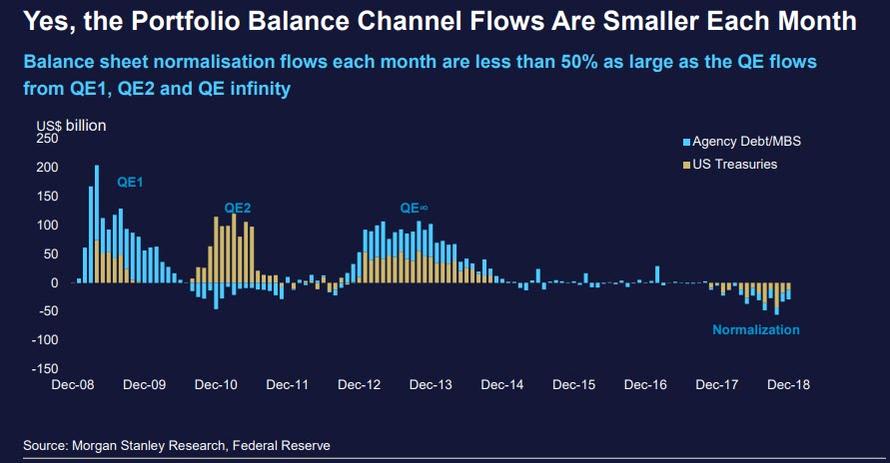Over the course of this year and next, the biggest economic risks will emerge in those areas where investors think recent patterns are unlikely to change. They will include a growth recession in China, a rise in global long-term real interest rates, and a crescendo of populist economic policies.
By now everyone has seen some iteration of this chart showing that the annual change in central bank liquidity is now negative.
Another way to visualize just the Fed’s balance sheet contraction is courtesy of this chart from Morgan Stanley which shows specifically which assets – Treasurys and MBS – are declining on a monthly basis.
When it comes to markets – where the events of December were a vivid reminder that just as QE blew the world’s biggest asset bubble, so QT will deflate it – there is a simple explanation of this negative effect of QT on Markets – in terms of both flow and stock – and it is laid out as follows from Morgan Stanley:
- THE STOCK EFFECT (SE) – GROUP 1
- The SE relates to the long-term impact on Group 1 asset prices from the overall change to the central bank’s balance sheet and its impact on the stock of available Group 1 assets.
- THE FLOW EFFECT (FE) – GROUP 1
- The FE relates to the short-term impact on Group 1 asset prices from each flow that changes the size of the central bank’s balance sheet.
- THE PORTFOLIO BALANCE CHANNEL EFFECT (PBCE) – GROUP 1 AND 2
- The PBCE impacts both Group 1 and Group 2 assets and incorporates the pricing elements of both the stock effect and the flow effect.
But while the immediate effect of the expansion and shrinkage of the Fed’s balance sheet on various asset classes is rather intuitive – if not to Fed presidents of, course – a more pressing question is how will the upcoming liquidity shrinkage affect the global economy.
Unfortunately, the answer appears to be ominous.
…click on the above link to read the rest of the article…



















CAMBRIDGE – As Mark Twain never said, “It ain’t what you don’t know that gets you into trouble. It’s what you think you know for sure that just ain’t so.” Over the course of this year and next, the biggest economic risks will emerge in those areas where investors think recent patterns are unlikely to change. They will include a growth recession in China, a rise in global long-term real interest rates, and a crescendo of populist economic policies that undermine the credibility of central bank independence, resulting in higher interest rates on “safe” advanced-country government bonds.1
A significant Chinese slowdown may already be unfolding. US President Donald Trump’s trade war has shaken confidence, but this is only a downward shove to an economy that was already slowing as it makes the transition from export- and investment-led growth to more sustainable domestic consumption-led growth. How much the Chinese economy will slow is an open question; but, given the inherent contradiction between an ever-more centralized Party-led political system and the need for a more decentralized consumer-led economic system, long-term growth could fall quite dramatically.1
Unfortunately, the option of avoiding the transition to consumer-led growth and continuing to promote exports and real-estate investment is not very attractive, either. China is already a dominant global exporter, and there is neither market space nor political tolerance to allow it to maintain its previous pace of export expansion. Bolstering growth through investment, particularly in residential real estate (which accounts for the lion’s share of Chinese construction output) – is also ever more challenging.1
…click on the above link to read the rest of the article…